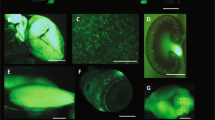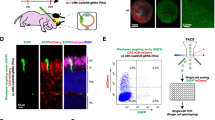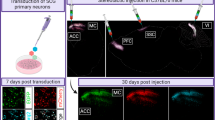Abstract
To monitor the presence of introduced genes and the distribution of the encoded proteins in host tissues after gene transfer, we combined fluorescence in situ hybridization (FISH) and immunohistochemistry in two separate gene therapy paradigms. In brain tissue sections from animals injected with pHSVIac vector, we localized nuclei containing vector DMA both in cells expressing and not expressing ß-galactosidase (ß-gal). This suggests that the efficiency of gene transfer is affected not only by gene delivery, but also by cellular controls on gene expression. In a second paradigm, following myoblast transplantation, we detected donor nuclei in the muscle of a patient with Duchenne's muscular dystrophy. The donor nuclei were either surrounded by host nuclei or apparently fused in the patient's muscle fiber producing dystrophin. The combined FISH and immunohistochemistry assay offers greater sensitivity and more information than currently used polymerase chain reaction and protein detection methods.
This is a preview of subscription content, access via your institution
Access options
Subscribe to this journal
Receive 12 print issues and online access
$209.00 per year
only $17.42 per issue
Buy this article
- Purchase on Springer Link
- Instant access to full article PDF
Prices may be subject to local taxes which are calculated during checkout
Similar content being viewed by others
References
Collins, F.S. 1995. Positional cloning moves from perditional to traditional. Nat Genet. 9: 347–350.
Grossman, M., et al. 1994. Successful ex vivo gene therapy directed to liver in a patient with familial hypercholesterolaemia. Nat. Genet. 6: 325–326.
DeMatteo, R.P., et al. 1995. Gene transfer to the thymus. A means of abrogating the immune response to recombinant adenovirus. Ann. Surg. 222: 229–239.
Bordignon, C., et al. 1995. Gene therapy in peripheral blood lymphocytes and bone marrow for ADA− immunodeficient patients. Science 270: 470–475.
Blaese, M.R., et al. 1995. T Lymphocyte-directed gene therapy for ADA− SCID: initial trial results after 4 years. Science 270: 475–480.
Knowles, M.R., et al. 1995. A controlled study of adenoviral-vector-mediated gene transfer in the nasal epithelium of patients with cystic fibrosis. N. Engl. J. Med. 333: 823–831.
Freed, C., et al. 1992. Survival of implanted fetal dopamine cells and neurologic improvement 12 to 46 months after transplantation for Parkinson's disease. N. Engl. J. Med. 327: 1549–1555.
Widner, H., et al. 1992. Bilateral fetal mesencephalic grafting in two patients with parkinsonism induced by 1-methyl-4-phenyl-1,2,3,6-tetrahydropyridine (MPTP). N. Engl. J. Med. 327: 1556–1563.
Kordower, J., et al. 1995. Neuropathological evidence of graft survival and striatal reinnervation after the transplantation of fetal mesencephalic tissue in a patient with Parkinson's disease. N. Engl. J. Med. 332: 1118–1124.
Gussoni, E., et al. 1992. Normal dystrophin transcripts detected in Duchenne muscular dystrophy patients after myoblast transplantation. Nature 356: 435–438.
Huard, J., et al. 1992. Human myoblast transplantation: preliminary results of 4 cases. Muscle & Nerve 15: 550–560.
Karpati, G., et al. 1993. Myoblast transfer in Duchenne Muscular Dystrophy. Ann. Neurol. 34: 8–17.
Mendell, J.R., et al. 1995. Myoblast transfer in the treatment of Duchenne's muscular dystrophy. N. Engl. J. Med. 333: 832–838.
Crystal, R.G. 1995. Transfer of genes to humans: early lessons and obstacles to success. Science 270: 404–410.
Blau, H.M. and Springer, M.L. 1995. Gene therapy—a novel form of drug delivery. N. Engl. J. Med. 333: 1204–1207.
Blau, H.M. and Springer, M.L. 1995. Muscle-mediated gene therapy. N. Engl. J. Med. 333: 1554–1556.
Leiden, J.M. 1995. Gene therapy—promise, pitfalls and prognosis. N. Engl. J. Med. 333: 871–873.
Wolff, J.A., et al. 1990. Direct gene transfer into muscle in vivo. Science 247: 1465–1468.
Dhawan, J., et al. 1991. Systemic delivery of human growth hormone by injection of genetically enginereed myoblasts. Science 254: 1509–1512.
Lynch, C.M., Clowes, M.M., Osborne, W.R.A., Clowes, A.W. and Miller, D.A. 1992. Long-term expression of human adenosine deaminase in vascular smooth muscle cells of rats: a model for gene therapy. Proc. Natl. Acad. Sci. USA 89: 1138–1142.
Stratford-Perricaudet, L.D., Makeh, I., Perricaudet, M. and Briand, P. 1992. Widespread long-term gene transfer to mouse skeletal muscles and heart. J. Clin. Invest. 90: 626–630.
Acsadi, G., et al. 1994. A differential efficiency of adenovirus-mediated in vivo gene transfer into skeletal muscle cells of different maturity. Hum. Molec. Genet. 3: 579–584.
Lichter, P., et al. 1988. Rapid detection of human chromosome 21 aberrations by in situ hybridization. Proc. Natl. Acad. Sci. USA 85: 9664–9668.
Lichter, P., et al. 1989. High-resolution mapping of human chromosome 11 by in situ hybridization with cosmid clones. Science 247: 64–69.
Trask, B.J. 1991. Fluorescence in situ hybridization: applications in cytogenetics and gene mapping. Trends Genet. 7: 149–154.
Buckle, V.J. and Kearney, L. 1994. New methods in cytogenetics. Curr. Op. Genet. & Develop. 4: 374–382.
Speel, E.J., Herbergs, J., Ramaekers, F.C. and Hopman, A.M. 1994. Combined immunocytochemistry and fluorescence in situ hybridization for simultaneous tricolor detection of cell cycle, genomic, and phenotypic parameters of tumor cells. J. Histochem. Cytochem. 42: 961–966.
Strehl, S. and Ambros, P.F. 1993. Fluorescence in situ hybridization combined with immunohistochemistry for highly sensitive detection of chromosome 1 aberrations in neuroblastoma. Cytogenet. Cell Genet. 63: 24–28.
Han, K.H., Hollinger, F.B., Noonan, C.A. and Yoffe, B. 1992. Simultaneous detection of HBV-specific antigens and DNA in paraffin-embedded liver tissue by immunohistochemistry and in situ hybridization using a digoxigenin-labeled probe. J. Virol. Meth. 37: 89–97.
Lu, Q.L. and Dover, R. 1993. Computer assisted signal co-localization for simultaneous detection of antigen by immunohistochemistry and DNA by non-isotopic in situ hybridization. Histochemistry 99: 23–27.
Tajabakhsh, S. and Houzelstein, D. 1995. In situ hybridization and ß-galactosidase: a powerful combination for analysing transgenic mice. Trends Genet. 11: 42.
Couwenhoven, R.I., Luo, W. and Snead, M.L. 1990. Co-localization of EGF transcripts and peptides by combined immunohistochemistry and in situ hybridization. J. Histochem. Cytochem. 38: 1853–1857.
Heppelmann, B., Senaris, R. and Emson, P.C. 1994. Combination of alkaline phosphatase in situ hybridization with immunohistochemistry: colocalization of calretinin-mRNA with calbindin and tyrosine hydroxylase immunoreactivity in rat substantia nigra neurons. Brain Res. 636: 293–299.
Larsen, P.J. and Mikkelsen, J.D. 1994. Simultaneous detection of neuropeptides and messanger RNA in the magnocellular hypothalamo-neurohypophysial system by a combination of non-radioactive in situ hybridization histochemistry and immunohistochemistry. Histochemistry 102: 415–423.
Geller, A.I. and Breakefield, X.O. 1988. A defective HSV-1 vector expresses Escherichia coli beta-galactosidase in cultured peripheral neurons. Science 241: 1667–1669.
Geller, A.I. and Freese, A. 1990. Infection of cultured central nervous system neurons with a defective herpes simplex virus 1 vector results in stable expression of Escherichia coli ß-galactosidase. Proc. Natl. Acad. Sci. USA 87: 1149–1153.
Geller, A.I., Keyomarsi, K., Bryan, J. and Pardee, A.B. 1990. An efficient deletion mutant packaging system for defective herpes simplex virus vectors: potential applications to human gene therapy and neuronal physiology. Proc. Natl. Acad. Sci. USA 87: 8950–8954.
Landon, D.N. 1982. Skeletal muscle-normal morphology, development and innervation, pp. 1–87 in Skeletal muscle pathology, Vol 1. Mastaglia, F.L. and Walton, S.J. (eds.). Churchill Livingstone, London.
Zagon, I.S. and McLaughin, J. 1979. Morphological identification and biochemical characterization of isolated brain cell nuclei from the developing rat cerebellum. Brain Res. 170: 443–457.
Smialowska, M., Bal-Klara, A. and Smialowski, A. 1988. Chronic imipramine diminishes the nuclear size of neurons in the locus coeruleus and cingular cortex but not in the hippocampus of the rat brain. Neurosci. 26: 803–807.
Knuutila, S., et al. 1993. Analysis of phenotype and genotype of individual cells in neoplasms. Cancer Genet. Cytogenet. 68: 104–113.
During, M.J., Naegele, J.R., O'Malley, K. and Geller, A.I. 1994. Long-term behavioral recovery in Parkinsonian rats by an HSV vector expressing tyrosine hydroxylase. Science 266: 1399–1402.
Geller, A.I., During, M.J., Haycock, J.W., Freese, A. and Neve, R. 1993. Long-term increase in neurotransmitter release from neuronal cells expressing a constitutively active adenylate cyclase from a herpes simplex virus type 1 vector. Proc. Natl. Acad. Sci. USA 90: 7603–7607.
Fraefel, C., et al. 1996. Helper virus-free transfer of HSV-1 plasmid vectors into neural cells. J. Virol. In press.
Verma, R.S. and Babu, A. (ed). 1989. Human chromosomes—manual of basic techniques. Pergamon Press, New York.
Beggs, A.H., Koenig, M., Boyce, F.M. and Kunkel, L.M. 1990. Detection of 98% of DMD/BMD gene deletions by polymerase chain reaction. Hum. Genet. 86: 45–48.
Lidov, H.G.W., Byers, T.J., Watkins, S.C. and Kunkel, L.M. 1990. Localization of dystrophin to postsynaptic regions of central nervous system cortical neurons. Nature 348: 725–728.
Byers, T.J., Kunkel, L.M. and Watkins, S.C. 1991. The subcellular distribution of dystrophin in mouse skeletal, cardiac and smooth muscle. J. Cell Biol. 115: 411–421.
Nishiyo, Y., et al. 1995. Identification and characterization of a gene regulating enzymatic glycosylation which is induced by diabetes and hyperglycemia specifically in rat cardiac tissue. J. Clin. Invest. 96: 1759–1767.
Monaco, A.P., et al. 1986. Isolation of candidate cDNAs for portions of the Duchenne muscular dystrophy gene. Nature 323: 646–650.
Author information
Authors and Affiliations
Rights and permissions
About this article
Cite this article
Gussoni, E., Wang, Y., Fraefel, C. et al. A method to codetect introduced genes and their products in gene therapy protocols. Nat Biotechnol 14, 1012–1016 (1996). https://doi.org/10.1038/nbt0896-1012
Received:
Accepted:
Issue Date:
DOI: https://doi.org/10.1038/nbt0896-1012
This article is cited by
-
Skeletal myoblast transplantation for attenuation of hyperglycaemia, hyperinsulinaemia and glucose intolerance in a mouse model of type 2 diabetes mellitus
Diabetologia (2009)
-
Medicinal chemistry of plasmid DNA with peptide nucleic acids: A new strategy for gene therapy
International Journal of Peptide Research and Therapeutics (2003)
-
Dystrophin expression in the mdx mouse restored by stem cell transplantation
Nature (1999)
-
The fate of individual myoblasts after transplantation into muscles of DMD patients
Nature Medicine (1997)
-
Recombinant adeno-associated virus for muscle directed gene therapy
Nature Medicine (1997)



